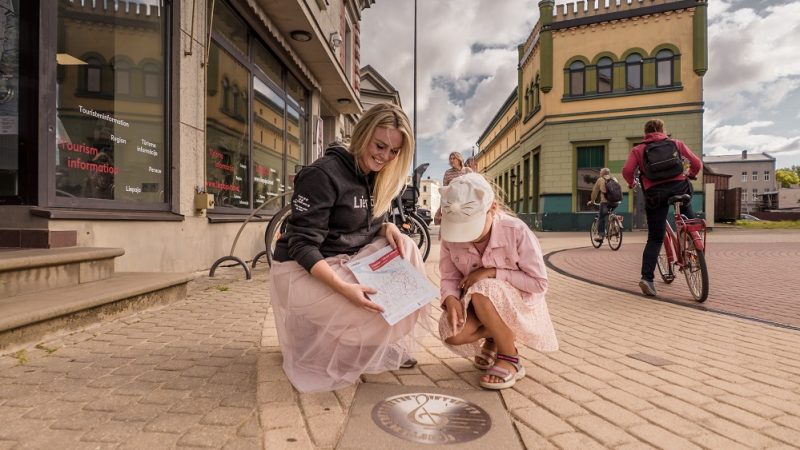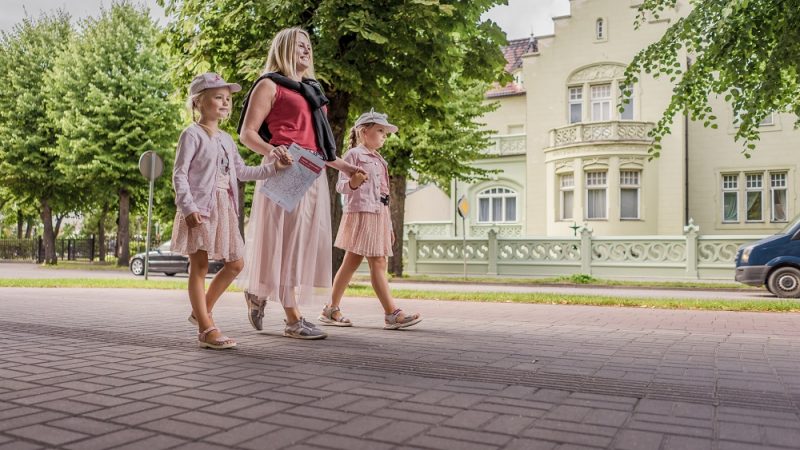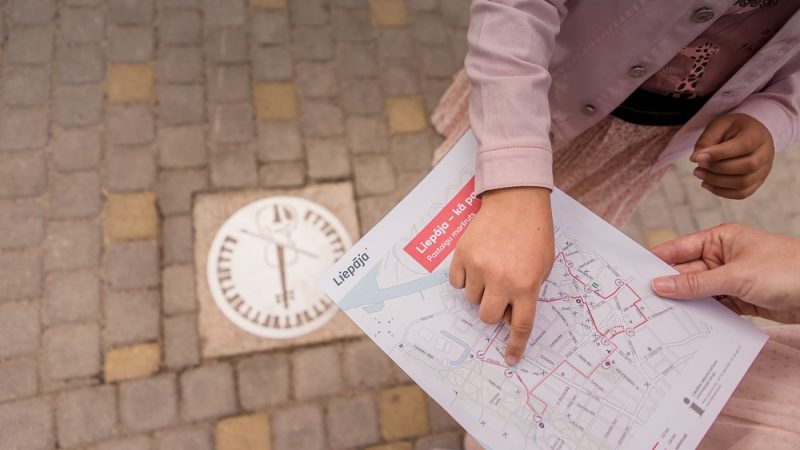The route “Liepaja – follow the notes!” is the easiest way to look at Liepāja and get to know the most remarkable historical, cultural and architectural values in the city centre. You are welcome to use our maps and follow the notes embedded in the cobblestones as your guidance.
The map in PDF format is available here.
A Clef – The Square of Roses
While continuing the route, take a look left in the Roman garden courtyard. The history of the Roman garden begins in 1882 with the miss the underground basements built beneath
the courtyard with the arts gallery in there, displaying a vast variety of the artwork collections from the Liepaja artists of the 20th century. The notes will continue taking you along Zivju Street, named after the fish market that used to be located just off Kuršu Square at the end of the street.
Do – Madame Hoyer’s Guest House
There are several unique 17th and 18th century buildings at the intersection of Kungu and Bariņu streets. The most remarkable building is a former Madame Hoyer’s guest house – one of the oldest residential houses in Liepaja, featuring now a 17-19th century interior museum. The stone building located to the left is a typical example of 17th–18th century construction. Whereas one of the city’s oldest remaining types of structures is located just behind Madame Hoyer’s house – the 17th century log house built on a low stone base foundation with a steep tiled roof. The walls of these old houses shelter tales and stories about the presence in Liepaja of Russian Czar Peter I and Swedish King Charles XII. Following the route, we advise you to pay attention to the unusual brick-covered pavement on Palmu Street, which was constructed about 150 years ago from over-burned bricks.
Re – Peter’s Market
Just opposite the entrance to the Peter’s Market, you will see the tallest building in the city centre – St. Anna’s Lutheran Church. The church’s 60-meter high redbrick spire dominates the skyline in the area. The church was consecrated in 1587 and has been rebuilt several times afterwards. Its most valuable asset is the 9.7-meter-high and 5.8-meter-wide wooden carved 17th century altar.
Mi – St. Joseph’s Cathedral
St. Joseph’s Cathedral is the largest Catholic Church in Kurzeme region, with magnificent and luxurious interior. The cathedral actually consists of two
buildings. A much larger church was constructed next to the initial small stone church in the 19th century swallowing it as a part of the present interior. The old church however was not dismantled. Its central altar was integrated into the new church as a left-side chapel, which you can easily distinguish by its floor level, located far below comparing to the new church. Outside, to the left of the Cathedral you will see the former Kurzeme Regional Court House, which now houses the Liepaja City Council.
From here, you can choose your walk direction – either return to the city centre or go to the park and beach.
- The 5.1 km route leads to the Seaside Park; please follow the signs with musical instruments.
Drums – Jānis Čakste Square
As we continue our walk, it leads us to the Peldu Street and your attention is immediately drawn to the neo-gothic style built redbrick residential house, designed in 1902 by the city’s chief architect, Paul Max Bertchy, standing out as one of his perhaps most remarkable projects.
Saxophone – Seaside Park
From here, you can easily walk down to the beach and see the famous attraction of holidaymakers due to its vast size and unusually white and delicate sand.
Violin — Swan pond
The residential area with mansions has grown around the pond. The most ornate wooden summerhouses are located on Hika and Vites Streets, adorned with fine decorative carvings.
Trumpet — Kurmajas Avenue
The residential area along the avenue was flourishing at a time when Liepaja became a popular resort at the edge of the 19th and 20th century. The city’s fine guests could hop on the tram to get to the park and the beach. The wealthy Liepaja businessmen considered building their mansions and rental houses on this street as a must to cement their status and prestige among the local society. One of these finest mansion examples, built in 1900, today is a home for the Liepaja Museum, where you can get to know the history of Liepaja and the region of Southern Kurzeme.
Along the entire Kurmajas Avenue you will also notice bronze sculptures of characters from the city anthem lines “The City where the Wind is Born” – a telephone operator, or a cable man on a pole, amber Latvians in a pub, a crow and a boatman.
- The 3.5 km route will continue through the city centre to the next note mark “Fa”.
Fa — Art-Nouveau buildings
Both routes meet again at the note “Sol” and continue alongside each other.
Sol – Liepaja State Gymnasium
Right behind the sculpture of a boatman, you can see the elegant decorative Art Nouveau building – the State Gymnasium, a former girls Gymnasium. It was built in 1912 according to the Ludwig Melville project. The street-side facade, which looks rather unaccustomed for the architecture of school buildings, is sophisticatedly refined and luxurious.
On the opposite side of Kurmajas Avenue you can see a white house with the same decorative facade of the building. This is the current district court and the former headquarters of the Russian-East Asian Steamship Company that provided a direct steamboat line between Liepaja and New York. Annually, about 40,000 people transitioned through the port of Liepaja and set out on a long journey from here to the New World.
To the right of the boatman’s sculpture is the former Navigation School, built in 1876. The central facade is decorated with a turret, used as the observatory for the needs of the nautical school.
Rest – Julianna courtyard
The route continues along the Trade Canal, which connects Liepaja Lake with the Baltic Sea. The canal was erected in 1703, and from that moment, the construction of a large and modern port began in the city. Walking along the promenade, you can see fishing boats and yachts. In addition, near the pedestrian ramp, you can explore a model of the surroundings of the canal area and an Amber Clock made from 50 litres of amber pieces donated for this by many residents of Liepaja.
La — The Concert hall “Great Amber”
The symbol of the cultural life of Liepaja is its Concert hall “Great Amber”. A venue for high-quality cultural and arts events where audience can enjoy some outstanding acoustics.
Si – Holy Trinity Cathedral
Holy Trinity Cathedral was consecrated in 1758. Its unique and most distinguished feature is the world’s largest unaltered mechanical organ.
- In the meantime, our route has ended. It was a pleasure for us to walk together with you and introduce you to the historical and modern values of Liepaja. See you next time!


